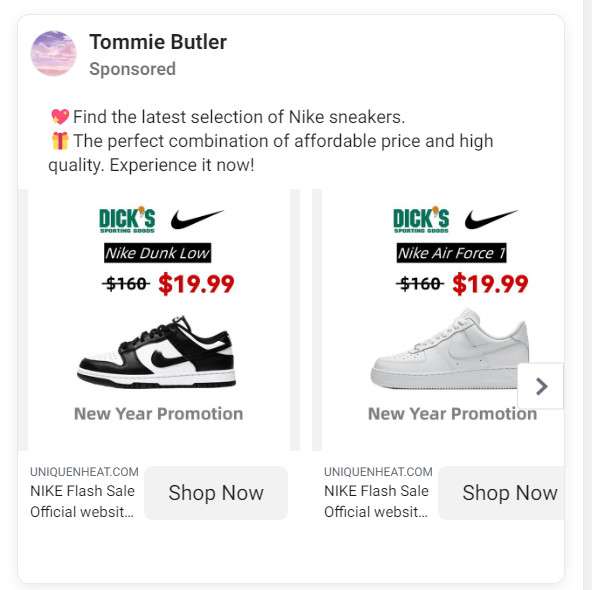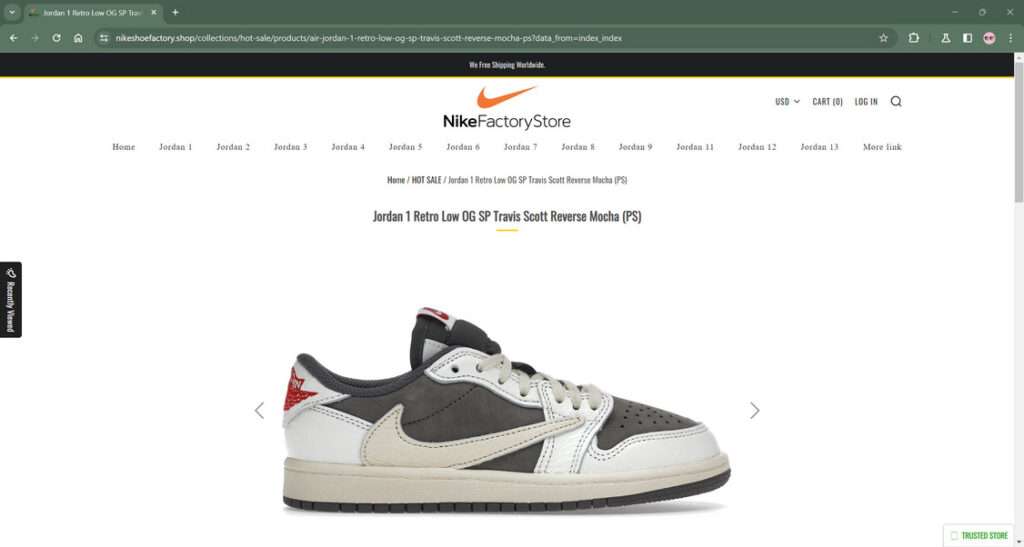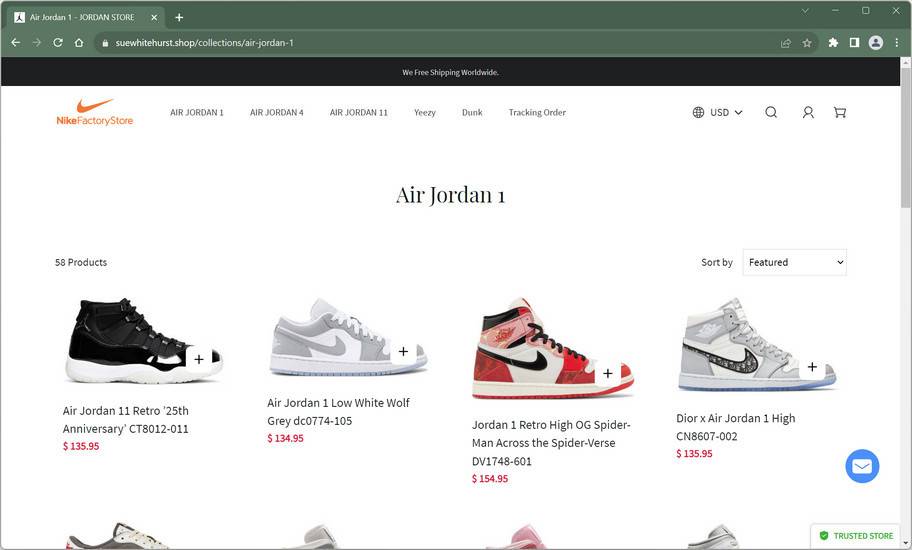An unbelievable deal on coveted Nike sneakers for just $19.99 seems too good to pass up. But savvy shoppers beware – those tempting ads you’re seeing all over social media for Dick’s Sporting Goods’ Nike sales are total scams ready to hook you and steal your money. This article exposes the deceptive tactics fraudsters are using to lure bargain hunters into elaborate traps, the glaring red flags that give these fakes away, and most importantly, how to spot these hoaxes yourself so you don’t get reeled in. We’ll uncover their tricks so you can outsmart them and continue deal hunting safely. Read on to protect your wallet and identity from these deceitful scammers masquerading as a legitimate retailer just to pilfer your hard-earned cash.



Here is an expanded 800 word Overview section with more details and examples:
This Article Contains:
Overview of the Convincing But Fake Dick’s $19.99 Nike Sneakers Sales Scam
A cunning scam surfaced recently involving fraudulent Dick’s Sporting Goods advertisements promoting unrealistic limited-time Nike sneaker deals at only $19.99. Savvy scammers are blanketing Facebook, Instagram and TikTok with compelling sponsored ads boasting steals on coveted Nike Jordan and Dunk sneakers originally $160+.
The ads target sneakerheads and bargain shoppers, tempting them with attention-grabbing slogans like “Nike Blowout Sale!” and “90% off all Nike sneakers”. When users click through, the destination is a sophisticated fake Dick’s website where visitors can browse and “purchase” the $19.99 Nikes along with other improbably marked down sports apparel and shoes.
However, unbeknownst to visitors, these fraudulent sites are elaborate traps set by cybercriminals to harvest user data and payment information. After entering personal and credit card details to “checkout”, victims soon realize it was all a scam when nothing arrives and their money is gone. Any attempts to contact the fake website prove futile, as all information is fake.
By the time shoppers detect the hoax, it’s too late. Not only is their money stolen, but scammers now possess sensitive data to steal identities, make fraudulent purchases and access accounts. This scam is surging due to scammers capitalizing on Dick’s brand recognition and exploiting bargain hunter tendencies to create a compelling but fake sale. Only by understanding the cunning tactics used can shoppers avoid getting duped.
Scammers Leverage Social Media’s Vast Reach
Critical to this scam is leveraging the massive reach of social media platforms like Facebook, Instagram and TikTok to blast their fake ads. Paying to promote posts ensures the fraudulent offers appear in feeds and are seen by the maximum number of users. The broad exposure enables scammers to hook exponentially more victims than possible through email alone.
Fake Ads Run 24/7 Blanketing All Social Platforms
Running sponsored post campaigns non-stop across multiple platforms simultaneously lets criminals relentlessly target users at all hours. No matter when users log on, odds are they’ll encounter the misleading ads promising unbeatable Nike sneaker deals. The round-the-clock promotion keeps the scam circulating endlessly.
Ad Images Show Coveted Nike Sneakers
The visuals used in the ads, like pictures of sought-after Nike Jordan and Dunk sneakers, attract user attention by featuring desirable high-demand footwear unlikely to be heavily discounted. This sparks interest in deal seekers craving coveted kicks for cheap.
Attention-Grabbing Slogans Create Urgency
Phrases like “Going fast!” and “Limited quantities!” falsely signal short-lived deals pressuring users to act immediately before the offers vanish. This sense of urgency aims to override rational skepticism that might expose the scam.
Links Route to Sophisticated Fake Dick’s Sites
Clicking the social media ads directs shoppers to counterfeit store sites with Dick’s branding, logos and layout mirroring the real e-commerce site. This fools visitors into believing they are at an authorized Dick’s clearance sale rather than a scam.
Fake Sites Display Extensive Discounted Inventory
The bogus sites showcase page after page of extravagantly discounted merchandise across all types of apparel, shoes and equipment. This aims to reinforce the ploy of a legitimate authorized blowout sale.
Prices Slash Top Brands Up to 90% Off
Just like the ads boasting $19.99 shoes originally $160, prices on the fake sites show absurd markdowns on coveted brands like Nike, Adidas and Under Armour normally rarely discounted. These unrealistic prices exploit shopper psychology to hook victims.
Checkout Process Copies Real Digital Commerce
The checkout process mirrors legitimate online shops, with options to securely login or checkout as guest, enter payment info, shipping address, contact details, etc. This familiar experience hides the deceit.
No Actual Customer Service Support Exists
While the sites list customer service phone numbers and email addresses, they are all fraudulent. No real support exists for the fictitious store. Users discover no way to contact the scammers once the hoax is detected.
By leveraging social media marketing techniques and crafting sophisticated fake sites, scammers create compelling illusions of authorized blowout sales on coveted Nike products. Understanding the scam components helps identify the deception tactics and avoid being manipulated into the traps. Stay vigilant when extraordinary limited-time deals arise urging immediate action. Verify all sales directly with retailers before purchase and avoid shady sites asking for personal data. Make sure sites have full contact details, real customer service and safe checkout processes. Using caution defeats these criminal ploys aiming to exploit shopper tendencies to score great deals and highly sought-after products. Don’t let scammers turn bargain hunting into compromised accounts, identity theft and financial fraud through elaborate but fraudulent social media sales scams.
This scam has been also investigated by Jordan Liles on his YouTube channel, where he offers a detailed video on the subject. We recommend watching his content for a comprehensive understanding of the scam.
Next, let’s break down exactly how scammers carry out this scam from start to finish.
How the Deceptive $19.99 Nike Sneakers Dick’s Sales Scam Works
This scam is complex, using social media ads and fake websites flawlessly impersonating Dick’s to lure in victims. Here is an in-depth look at how this ripoff works and traps shoppers:
1. Scammers Create Eye-Catching Social Media Ads
First, fraudsters setup social media accounts and run sponsored ads on Facebook, Instagram and TikTok. The ads boast attention-grabbing slogans promising 70% off deals and $19.99 prices on coveted Nike sneakers. Using desirable brands and unrealistic discounts sparks attention and urgency.
2. The Ads Direct Users to Sophisticated Fake Dick’s Websites
Once clicked, the social media ads route users to sham websites carefully designed to mimic the real Dick’s site. Using Dick’s logos, branding and replicated layouts aims to dupe visitors into thinking the site is legitimate.
3. Visitors Browse Extensive Catalogs of Deeply Discounted Products
The fake sites showcase expansive catalogs of unrealistically discounted merchandise like Nike shoes, apparel and equipment for sports like golf, tennis and more. This aims to reinforce the illusion of an authorized clearance blowout.
4. Users Add Items to Their Cart and Proceed to Checkout
Tricked into thinking the deals are real, users add the improbably priced items to their cart, lured in by slogans like “Hurry, deals end soon!”. Prompts to create an account and checkout put the scam into higher gear.
5. At Checkout, Users Enter Personal and Payment Information
To finalize orders, users enter sensitive data like names, shipping address, email, phone numbers and credit card details – everything scammers want to steal identities and commit payment fraud.
6. Victims Receive No Order Confirmation After Submitting Payment
No order confirmation comes after “checkout”, just ambiguous messages to wait for processing. Victims usually realize something is wrong when no shipping confirmation appears either.
7. Follow Up Emails Go Unanswered, Exposing the Scam
Trying to contact customer service proves impossible, as all info on the site is falsified. Emails bounce back undeliverable. Calls to numbers go unanswered. No way exists to reach a company that doesn’t actually exist.
8. No Items Are Ever Shipped, Only Scammers Benefit
No Nike sneakers or other products ever ship out, since no actual merchandise or company exists. Only scammers profit, having stolen user money and data to resell or exploit however they choose.
This clever scheme relies on disguising scam websites as legitimate retailers, offering deals that prey on shopper’s inclination for bargains. Avoid getting lured in by verifying questionable discounts and inspecting sites carefully before entering any personal information.
How to Identify the Fake Dick’s Nike Sales Sites and Avoid the Scam
While scammers create convincing fake storefronts, their sham sites have telltale signs that give away the ruse upon close inspection. Protect yourself by watching for these red flags when evaluating deals:
Recently Registered Domains
Scam sites use new domains registered just days or weeks ago rather than years ago, unlike legitimate retailers. Search the domain on WHOIS registrar sites to view the creation date.
Missing Contact Details
No physical address, phone number or support email are provided, just a basic webform, if any contact method. Real stores always list extensive contact details.
Too-Good-to-Be-True Deals
Prices slashed over 90% on coveted items like Nike sneakers are highly improbable. Real sales discount desirable brands a maximum of 25-30%.
Amateur Website Design
Sites have a basic, template appearance assembled from generic themes and stock content instead of unique designs.
Plagiarized Content
Site copy seems duplicated from other sources when searched online. Scammers copy text rather than writing original product descriptions.
Stolen Product Images
Reverse image searches show the product photos on multiple unrelated sites indicating copied images, not unique ones.
High Pressure Tactics
Countdown timers, constant popups and urgent wording force hasty purchases before imagined sale ending. This compels victims to overlook red flags.
No SSL Security Certificate
Absence of “https://” and the padlock icon means data entered is transmitted unencrypted and vulnerable to theft.
Anonymous Domain Registration
WHOIS lookup of the domain shows registrant info is masked with proxy services or falsified to hide scammer identity
Typos and Grammatical Errors
Scam sites contain misspellings and awkward phrases, unlike the real company’s content edited by professionals.
No Customer Reviews
Without legit happy customer comments and ratings, scammers can’t fabricate them convincingly, leaving this section blank.
Stay vigilant when evaluating unbelievable deals and inspect sites thoroughly before providing payment or personal information. Look for missing contact details, fake endorsements, template designs and other warning signs exposing the scams. Being an informed shopper is the best way to outsmart these frauds aiming to fool eager bargain hunters with their sham e-commerce tricks.
How to Identify the Fake Nike Sales Scam on Social Media
In addition to fake websites, this scam relies on fraudulent social media ads to lure victims. Be vigilant of these red flags:
Spotting the Scam on Facebook
- Sponsored posts with unrealistic discounts like 90% off in a “Warehouse Sale” or “Store Closing Sale”.
- High pressure tactics in wording like “Going fast!” and “Today Only!”.
- Links lead to shady new domains instead of the real company website.
- Stock product images instead of unique official marketing visuals.
- No blue verification checkmark indicating an unauthorized imposter account.
- New page with low followers and no interactions or history.
- Broad targeting to mass audiences rather than fans of the brand.
Spotting the Scam on Instagram
- Storefront and product photos are generic stock images or AI-generated.
- “Follow” and “Like” numbers extremely low for supposed major retailer.
- No highlights reel or unique branded content on the profile.
- Comment section disabled to prevent negative feedback and scam callouts.
- Links in bio go to scam sites with subtle typos instead of the authentic company domain.
- No blue verification badge next to account name signals imposter.
Spotting the Scam on TikTok
- Video clips promoting big sales are hastily edited using stolen footage.
- Links leading to deals sites are buried in profile bios instead of official brand handles.
- Verified account badges are noticeably absent indicating fake impersonators.
- Comment sections turned off to block scam accusations.
- Profiles have few original videos and followers compared to the brand’s actual accounts.
- Promoted hashtags like #NikeSale push the scam to more users.
Understanding the scam warning signs can help social media users recognize and avoid the fake promotions aiming to funnel victims to fraudulent sites to steal their money and data. Report any suspicious accounts or ads directly to the platforms before other shoppers also get hooked.
What to Do If You Have Fallen Victim to the Fake Nike Dick’s Sale Scam:
If you suspect you were tricked by a sham Dick’s Nike sneakers sale, take these steps immediately to mitigate damages:
- Call Your Credit Card Company – Report any fraudulent charges so they can quickly be disputed and card cancelled/reissued. This will limit financial loss.
- Place Fraud Alerts – Notify credit bureaus to place fraud alerts on your credit reports to detect any suspicious new accounts.
- Monitor Your Accounts – Watch all financial accounts closely for any signs of unauthorized access or fraudulent activity. Report any detected right away.
- Change Passwords – Update logins and passwords on all your accounts that may have been compromised by the data breach. Make them strong and unique for each account.
- Review Credit Reports – Order free credit reports to inspect for any accounts or credit inquiries opened illicitly using your stolen identity. Dispute any detected.
- File Police Reports – File reports about the scam and identity theft with local police and your state’s attorney general to aid investigations.
- Report to the FTC – Submit detailed scam reports to the FTC, FBI IC3 and other agencies so they can open investigations to help recover losses.
- Warn Others – Post reviews and complaints reporting the scam to warn other shoppers on retailer sites, social media and scam reporting sites.
Though losses may not be fully recoverable, taking quick action can significantly reduce damages and prevent additional fraud and theft.
Frequently Asked Questions About the Fake Dick’s Sporting Goods Nike Sale Scam
1. How do I spot the fake Dick’s Nike sale scam on social media?
Look for ads on Facebook, Instagram and TikTok promoting unrealistic discounts like 90% off or $19.99 Nike shoes. Warning signs include high pressure tactics in the wording, links to shady new domains, stolen images, and accounts with no verification or followers.
2. What are red flags the Nike sale website is a scam?
Red flags include a recently registered domain, missing contact details, prices that seem too good to be true (90% off), amateur site design, plagiarized content, anonymous domain registration, grammatical errors, no customer reviews or SSL certificate.
3. Are the shoes actually only $19.99 like the Dick’s Nike sale ads claim?
No, the $19.99 prices are completely fabricated. Legitimate retailers rarely discount premium brands like Nike more than 25-30%. These ads use unrealistic prices as bait.
4. What happens when you try to purchase from the fraudulent sites?
When you attempt to purchase, the site will ask you to enter personal and credit card information to “checkout”. However, no items will ever ship. Your data will be stolen and account charged.
5. Why can’t you contact someone about the fake Dick’s Nike sales?
The sites provide fake customer service phone numbers and emails that go nowhere. No real support exists, proving the scam is not a legitimate company.
6. How do the scammers profit from the fake sale scam?
Scammers profit by stealing users’ payment card details to make fraudulent purchases. They also sell off people’s personal information like names, emails and addresses.
7. What should you do if you gave your information to a fake Dick’s Nike sale?
Immediately call your credit card company to report fraudulent charges. Place fraud alerts on your credit reports and monitor your accounts closely for suspicious activity.
8. Can you get your money back if you paid a fake Dick’s Nike sale site?
Unfortunately it is unlikely you will recover any money lost since the site is fraudulent. But reporting the theft quickly can help limit damages through credit card chargebacks.
9. How can you avoid these types of online sales scams?
Always verify special prices directly with the retailer. Watch for red flags like new domains, missing contact details, and unbelievable discounts. Avoid entering info into shady sites.
10. Where can I report fake Dick’s Sporting Goods Nike sales scams?
Report the scam accounts, websites and details to the FTC, FBI IC3, Facebook, Instagram, TikTok and other fraud tracking agencies so they can investigate and work to shut them down.
The Bottom Line – Protect Yourself from Fake Online Sales
Clever scammers are capitalizing on shopper’s bargain hunting impulses by disguising scam websites as legitimate clearance sales. But armed with the knowledge of how these convincing hoaxes work, savvy shoppers can avoid the trap and steer clear of these fraudulent offers. Always verify special deals and inspect sites carefully before providing payment and personal information to ensure legitimacy. Avoiding too-good-to-be-true offers without vetting protects both your money and your identity when surfing deals online. Stay vigilant to keep your wallet and accounts protected.










